
The First and Only Weekly Online Fanzine Devoted to the Life and Works of Edgar Rice Burroughs |
 |

The First and Only Weekly Online Fanzine Devoted to the Life and Works of Edgar Rice Burroughs |
 |
|
See below |
There are rumours that the ERB
fans of Tarak's THB List are
planning a hazardous mission
to Okar later in the summer.
Our daughter, Tara of the North
and her savage calot companion, Atticus,
will be on the lookout for any
trouble these travellers may run into.
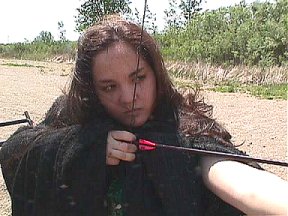

Meanwhile a few glimpses of the
adventures experienced by
Hadron, The Brooklyn Banth last
week
after being rescued from his
downed flier.
The full-story will follow in
a future edition of ERBzin-e
June 2002 OKAR'n'R Mission
Dejah Vu
For the second time in two years
Hadron of Hastor's storm-ravaged
flier finds sanctuary in the
Okar
Imperial Palace of JoN & Dej
Place mouse cursor on images for pop-up captions
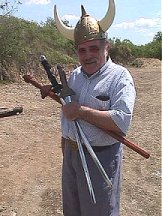
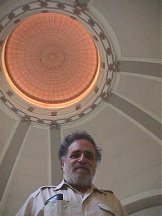
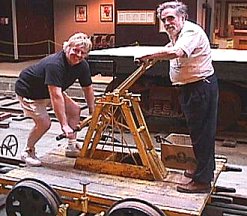
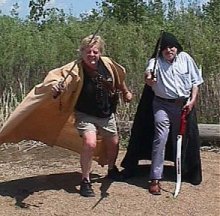
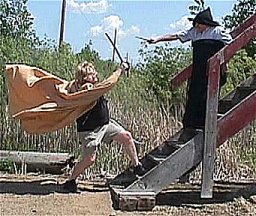
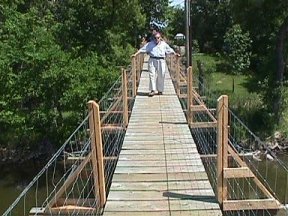
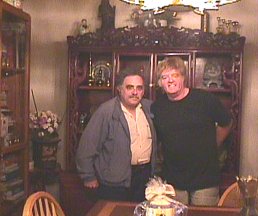
Visit Princess Dejah's Garden of Jeddaks and Amtorian Gardens at:
http://www.erbzine.com/mag2/0216.html
See highlights of last year's exciting adventures of Hadron in Okar
at:
http://www.erbzine.com/mag5/0559.html
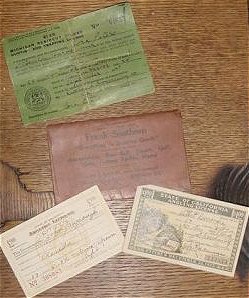 |
Two California Angling Licenses from 1923 and 1930 issued to Hulbert Burroughs (age 14) and John Burroughs (age 17) both of Reseda, California. The licenses are contained in a folder "Compliments of Frank Southern Everything in Sporting Goods" Chicago, Ill. |
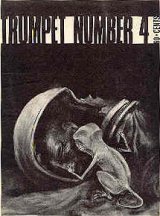 |
TRUMPET #4 April 1966 edited and published by Tom Reamy.
48 page fanzine printed offset. “Tarzan and How He Grew or Whatever Happened To Jane Baby?” by John McGeehan, a substantial nonfiction article on Tarzan and Edgar Rice Burroughs material in films, books and comics, the first installment of the graphic novel of THE BROKEN SWORD by Poul Anderson, beautifully adapted by George Barr, nonfiction by Jerry Pournelle and Andrew J. Offutt, fanzine reviews by Alex Eisenstein, article on Dr. Who, “The Science Fantasy Film Revisted” by Tom Reamy with looks at a variety of science fiction and horror films, with b & w stills, letters of comment. Trumpet was always one of the best fanzines of the era, in terms of content and production quality. |
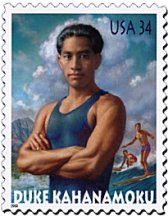 |
This new 37-cent US stamp honours Hawaiian swimmer, surfer and Olympic Games gold medalist Duke Kahanamoku, who was renowned not only for his athletic prowess but also for his grace, humility and good sportsmanship. He is widely considered to be the father of international surfing, and for much of his life he served as a living symbol of hospitality and goodwill to the rest of the world. The portrait on the stamp, an oil painting by Michael J. Deas, is based on a 1918 photograph from the collection of the Bishop Museum in Honolulu. Visible in the background are depictions of Diamond Head and two surfers riding a wave at Waikiki Beach. |
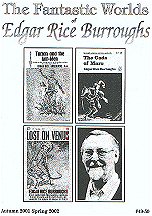 |
The Journal of The Edgar Rice Burroughs Society Nos: #49-50 ~ Autumn 2001 Spring 2002 CONTENTS Tarzan's Secret Debt to Mowgli by John Harlow Review of Mike Chapman's The Life Story of Herman Brix / Bruce Bennet by Rod Jackson A Visit with Maria Weissmuller by David Fury From the Depths of Omean by Fran Westwood Pellucidar Revisited, Chapter 7: Fan fiction by Tony Phillips Artist's Page by Daniel Reed Mortelmans The Magnificent: Interview and Art Samples by Frank Westwood Mytery of the Two U33 Submarines by Frank Westwood In Search of The Outlaw, Part 3, The Battle of Lewes by Rod Jackson Fortunio Matania continued by Frank Westwood The Legend of Mad Jack Clayton by Arthur Stone |
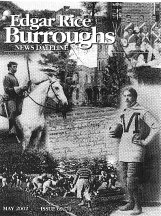 |
May 2002 ~ Issue 69/70 CONTENTS (recent newspapers, magazines, obituaries, periodicals, comics, fanzines & fan publications, books, forthcoming books, Disney Tarzan books, coloring/activity game books, audio, videos/DVD, trading cards, school supplies, plush toys, toys, games, health/beauty products, clothing, Tarzan clocks and watches, Tarzan pins/buttons, esoteric items, McDonalds, catalogs of note) Dum-Dum 2001: A Florida ERB Odyssey by Mike Conran Michigan Military Academy Symposium by Mike Conran ECOF 2001: Binghamton, New York by Mike Conran Weissmuller in BVD Swim Club 1929 photo |

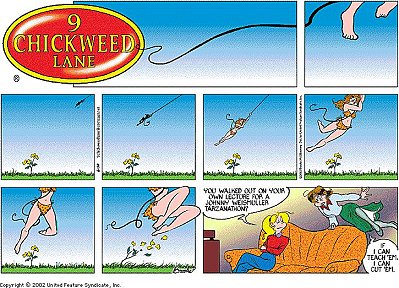


George Alec Effinger, a science-fiction writer who won top awards in his literary field, died Friday of undetermined causes at his New Orleans home. He was 55.A Cleveland native who had lived most of the past 30 years in New Orleans, Mr. Effinger wrote hundreds of short stories and more than 20 books, including mysteries and crime novels in addition to science fiction. He also created several computer role-playing games.
He is perhaps best known for "Schrodinger's Kitten," the novelette that won both the Hugo in 1988 and the Nebula in 1989, science fiction's most prestigious awards. His other well-known works were a trilogy of futuristic stories, influenced by Raymond Chandler and based on the recurring character of detective Marid Audran: "When Gravity Fails," "A Fire in the Sun" and "The Exile Kiss," in which the French Quarter is transformed into a futuristic Arabic city called the Budayeen.
Other works include the novel "What Entropy Means to Me" and the award-winning short story "The Aliens Who Knew, I Mean, Everything." But Mr. Effinger's work, filled with fine characterization and dark humor, transcended genre.
Mr. Effinger originally intended to become a surgeon but dropped out of Yale University to live in New York. He returned to Yale, but soon it became clear that writing would be his chosen profession.
His first wife, whom he met while she was browsing in the science-fiction section of the New York bookstore where he worked, introduced him to Damon Knight and Kate Wilhelm, two of the best-known science-fiction writers in the country, who became important mentors to Mr. Effinger.
He said that his writing career really began with a summer writing workshop in Pennsylvania in 1970: "I wrote my first story, sold my first novel, and I never looked back."
Mr. Effinger moved to New Orleans after attending a writing workshop at Tulane University in 1971, and, finding the city an inspiration, he entered his most productive writing period. In addition to writing, he taught a popular creative-writing class at the University of New Orleans Metropolitan College, and many of his students went on to become friends, meeting with Mr. Effinger in a monthly writing group. He was a frequent guest at science-fiction conventions throughout the country and a collector of Depression glass, which played an important part in his novel "Heroics."
His favorite word, he once said, was "terrific." "I have my characters say it under any possible circumstances. It means whatever it means at the moment, from tremendous praise to tremendous put-down."
When Mr. Effinger married his third wife, novelist Barbara Hambly, in 1998, he moved to Los Angeles. "We were co-guests of honor at a science-fiction convention, and it was love at first sight," Hambly said. "We were married in November of 1998."
Mr. Effinger returned to New Orleans in the spring of 2000 after he and Hambly divorced. "He had talent to burn, and he burned it," Hambly said. "One of the most frustrating things about him was seeing what he could have done. We were in touch daily. Since the divorce and since he moved back to New Orleans, we spoke daily. We were best friends."
Mr. Effinger's life was complicated by recurring illness and addictions to painkillers and alcohol, Hambly said. "In the last four years of his life, he went through rehab twice, he was in 12-step programs. The last five months of his life he was completely clean and sober. He was working again, he has two short stories in anthologies coming out in the next couple of months, and he had a good shot at getting his life back together and starting his career again. He put up a hell of a fight."
Mr. Effinger, long appreciated worldwide in science fiction circles, regretted not having a higher profile in his adopted hometown. "I'm to Japan what Jerry Lewis is to France. They love me over there," he once said.
Mr. Effinger is survived by Hambly, who is his literary executor. A memorial may be planned later.
Effinger was perhaps best known for a series of stories featuring Maureen Birnbaum, a shopping-crazy teen dropped into settings and situations that parody science fiction. The stories were collected in 1993 in Maureen Birnbaum, Barbarian Swordperson. See Defending Maureen Birnbaum.
Of particular interest to Burroughs fans is his Mars: The Homefront which views Wells's War of the World invasion of Earth through the eyes of Edgar Rice Burroughs.
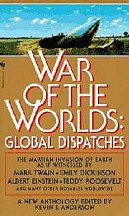
EFFINGER LINKS TO EXPLORE
http://www.locusmag.com/index/f7.html
http://www.fantasticfiction.co.uk/authors/George_Alec_Effinger.htm
http://www.areasofunrest.net/43/3May2002.html
http://www.inu.org/pihua/200205/entry1.htm
http://www.silcom.com/~manatee/effinger_maureen.html
http://www.myunicorn.com/bibl32/bibl3227.html
http://www.geocities.com/Area51/Shadowlands/6696/pastiches.htm
http://www.pjfarmer.com/woldnewton/Central.htm
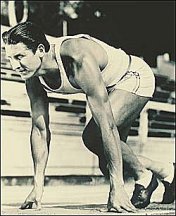
Sunday, June 30, 2002 - SIMLA - Glenn Morris' tiny hometown on the parched prairie of Elbert County still doesn't have a stoplight. But it does have an Olympic gold medal, which when removed from a Simla High School vault can stop what little traffic there is just the same.Surrounded by farms and ranches, Simla most notably raised a rocket in the Hollywood-handsome Morris, whose rapid ascent to fame if not fortune was matched only by the speed of his life's tragic descent.
Six years after leaving to star at Colorado A&M, which became Colorado State, Morris returned to Simla an Olympic champion, having broken the world record in the decathlon at the 1936 Berlin Games. He appeared in two 1938 movies, one as Tarzan, and played briefly in the NFL for the Detroit Lions before fighting as a Naval officer in World War II. After the war, he all but disappeared from the public eye until his death from heart failure in Burlingame, Calif., in January 1974 at age 61.
"You basically can divide Glenn's life into two segments," said Mike Chapman, whose book about Morris - "Colorado Comet" - is near publication. "You have what he did up to and including the '36 Olympics, which was as good as it gets, a classic rags-to-riches story, and everything after the '36 Olympics. That's the sad part."
A standout for the Simla Cubs in football, basketball and track, Morris boosted his conditioning by running the 2 miles between school and home. Cledys Moore, a neighbor and teammate, occasionally ran with him. "We lived about half a mile apart, but that's pretty close for country people," said Moore, 91, a Simla resident most of his life. "Glenn was a good uy and a great athlete. I can still see him running the hurdles. He was so smooth, he seemed to glide over them. He did everything so well; he won track meets for us single-handedly. "Good as he was, though, we had no idea in Simla he'd become what he became."
Other than Harry Hughes, who coached football, basketball and track at CSU, nobody did. Hughes was thrilled when the 6-foot-2, 185-pound Morris arrived in Fort Collins in the fall of 1930. "I knew he was a gem," Hughes said years later. "I could see he was quick, coordinated and had a hair-trigger mind." Morris didn't disappoint Hughes, helping CSU win a share of the Rocky Mountain Athletic Conference football title in his senior season, 1933, when he was a receiver. On the track, he set school records in the hurdles and scored points in several events. In the classroom, he earned degrees in economics and sociology.
A bold vow
Morris' life changed when he attended the 1932 Los Angeles Games with Hughes. On the spot, Morris decided he could become an Olympian when he watched Jim Bausch of Kansas use a world-record performance to win the decathlon. "Someday I'll win it," Morris told himself, "and I'll win by more points than anyone has ever scored." That bold vow eventually turned into bolder victories. With Hughes' help, Morris learned the techniques to compete in the events of the decathlon - 100-meter dash, long jump, shot put, high jump, 400 dash, 110 hurdles, discus, pole vault, javelin and 1,500-meter run. He was a 23-year-old car salesman training in Fort Collins for the Berlin Games when he competed in his first decathlon, at the Kansas Relays, in April 1936. He set the American record, scoring 7,576 points, which qualified him for the U.S. Olympic Trials two months later in Milwaukee. There he scored 7,880 points, shattering the world record set in 1934 by Germany's Hans Sievert. "Morris combines extraordinary speed with the technique and stamina so essential to sustaining a high average of performance in the 10-event test," AAU national secretary Daniel J. Ferris said at the time.
Simla's sensation took aim at his third, and last, decathlon while sailing to the Berlin Games aboard an ocean liner with Jesse Owens and other U.S. teammates. When he arrived, Morris was more concerned than confident. "I gained about 8 pounds going over on the USS Manhattan," he said years later. "It rained most of the time, and I had a hard time losing it. I caught cold, which settled in my muscles, and was too tensed up to work out for two days."
Morris eventually caught the attention of Adolf Hitler, who was among the 90,000 spectators at Olympic Stadium when Morris was crowned decathlon champion of the Berlin Games. Morris broke his world record, accumulating 7,900 points, by posting career bests in the shot put (46 feet, 2 inches), 110-meter hurdles (14.9 seconds), discus (141-5) and the final event, the
1,500 meters, which he won with a time of 4:33.2, 16 seconds faster than his previous best and one second better than the time needed to set the world record. He received his laurel wreath from Eva Braun, Hitler's mistress, and returned home a hero."Simla couldn't have been prouder," Moore said. "I think we started planning Glenn Morris Day the day we heard he'd won the Olympics. That was a big deal, as you can imagine, even bigger than him being in the movies."
An instant celebrity, Morris was funneled into the fast lane. After taking part in New York's ticker-tape parade for the U.S. Olympic team, Morris was given a parade in downtown Denver. He then flew to Simla, about 90 miles southeast of Denver, by helicopter for another ceremony. When he surprisingly beat out Owens, the Ohio State star who won four gold medals in Berlin, for the Sullivan Award as the nation's top amateur athlete of 1936, Morris found himself bigger than the ranch north of Simla on which he was raised.
"Glenn Morris was as big as big could get in America in 1936," said Chapman, a longtime newspaperman who was sports editor of the Fort Collins Coloradoan from 1971-76 and now is executive director of the International Wrestling Institute and Museum in Newton, Iowa. "Everything he did was front-page news."
Everything included Morris' wedding and marital problems that led to a much-publicized divorce, his career as an actor that ended almost as quickly as it started and combat in the South Pacific that left him emotionally scarred.
Chapman spent parts of the past 16 years researching and writing Morris' biography and isn't sure he was able to completely cover a compelling life that appeared so terrific one day, so troubled the next. Moore has heard all the stories. "After he achieved all the glory," Moore said, "Glenn became a pretty big name. Sometimes that throws people off. But it's sad the turn his life took, very sad. "It was difficult to believe it was the same Glenn Morris. He achieved so much, and then it all seemed to vanish."
Morris married Charlotte Edwards, a teacher who grew up in Sterling, in December 1936. They met while students at CSU, and she helped him train for the Olympics by timing his workouts and helping him keep his diet in order. They divorced less than three years into the marriage.
The couple had moved to Hollywood after the Olympics so Morris could become an actor. His first film, "Hold That Co-ed," helped him get a five-year contract with producer Sol Lesser. The agreement, reportedly worth $250,000, cast him with former Olympic swimming champion Eleanor Holm in "Tarzan's Revenge." The film was a box-office flop, primarily because Lesser's budget and script lacked substance. Morris never appeared in another movie, and he received only a small fraction of the income he thought the contract would provide.
After his divorce, Morris made the Detroit Lions' roster but sustained a season-ending injury during the 1940 opener. He turned to military service, commanding an amphibious-assault landing craft during World War II that transported troops and equipment to bloody beaches. "War can change a man," Moore said, "and I know it changed Glenn. From what I was told, he was never the same."
War took its toll
Morris emerged from the war - some of the fiercest fighting he took part in occurred during the Battle for Leyte Gulf in October 1944 - to find steady income difficult to acquire. He sold insurance and also dabbled in fields as varied as broadcasting and construction. Constantly battling poor health brought on by post-battle stress syndrome, he was a frequent patient at veterans' hospitals in California.
"His parents lived into their mid-80s and his siblings lived into their mid-80s, but he died at 61," Chapman said. "And he was the one with the perfect body."
Bob Mathias believes he met Morris before the descent picked up speed. It was 1949 and Tulare, Calif., Mathias' hometown 45 miles south of Fresno, was host to the national decathlon championships. Morris came to see Mathias, the reigning Olympic champion.
"He was one of my heroes," Mathias, 71, said from his Fresno home, "so I was thrilled to meet Glenn. He offered great support and was very interested in my career as a decathlete. I have a photograph of me, my dad and Glenn sitting in our backyard, and it's one of my favorite pictures. Glenn was dressed in a suit and looked great, and after he left I remember me and my dad
saying, "Boy, now that's a real good guy.' "Mathias was 17 when he won the Olympic decathlon at the 1948 London Games. He repeated as gold medalist at the 1952 Helsinki Games, two years after breaking Morris' world record. "The two names I heard about growing up were Jim Thorpe and Glenn Morris," Mathias said, "and after winning in '48 the numbers I went shooting for were Glenn's numbers. They were super numbers, especially when you consider how few decathlons he competed in. You wonder why he didn't keep it up, why he walked away from it. But Hollywood came calling, which erased his amateur status at a time when Olympians were strict amateurs, and then there was a war. "I knew a little about his problems, that he was down and out for a while and that he didn't have an easy life after the war. Sure it's sad. Most decathlon (champion) guys I know have done fairly well with themselves. We're not what you'd call wealthy, but we've had good lives for the most part. None of us understood war like Glenn did, though. The combat he was in and was around must have been truly terrible."
Morris' health deteriorated in his final years to the point he was unable to attend his 1969 induction into the Colorado Sports Hall of Fame. While director of the Olympic Training Center in Colorado Springs from 1977-84, Mathias accepted an invitation from Simla to see Morris' hometown and give a speech at the school. He thought Tulare producing an Olympic champion was remarkable until he saw Simla, which has about 500 residents. Tulare's population, Mathias said, was about 13,000 when he was dedicated to the decathlon.
"Everything about Glenn Morris seems incredible," Mathias said. All the more reason to cherish his memorabilia, much of which was donated to Simla High School after Morris' death. The school began the Glenn Morris Award, given annually to students who excel athletically and academically, in the 1970s. "Simla never stopped being proud to be Glenn's hometown," Moore said. "Even though he was always just Glenn Morris to us, we didn't mind him being famous."
PHILIP JOSE FARMER
Peoria, Illinois ~ Aug 10, 2002
WRITERS LIVE EVENT: "The Lover’s Celebration: The 50 th Anniversary" of the publication of Philip Jose Farmer’s first science fiction story, The Lovers, 2 PM, Lakeview Branch Library. The Lovers, a groundbreaking story about aliens and humans, led to Farmer’s winning the 1953 Hugo Award for Most Promising New Talent. Fans from across the U.S. and as far away as England are coming to Peoria for this 50th Anniversary Celebration. Tributes from other Science Fiction Luminaries will be read. Author’s Reception sponsored by Friends of Peoria Public Library. Books will available for sale and signing. Open to the public. FREE 497-2141
http://www.pjfarmer.com/forum/For more on Farmer's connection with ERB see our PJF sites in ERBzin-e:
http://www.angelfire.com/trek/erbzine3/erbmot65.html
http://www.angelfire.com/trek/erbzine3/erbmo65a.html
http://www.angelfire.com/trek/erbzine3//erbmo65b.html
QUOTES:
"The world is so exquisite, with so much love and moral depth, that there is no reason to deceive ourselves with pretty stories for which there's little good evidence. Far better, it seems to me, in our vulnerability, is to look Death in the eye and to be grateful every day for the brief but magnificent opportunity that life provides." --Carl Sagan
"Those who contemplate the beauty of the Earth find reserves of strength that will endure as long as life lasts." --Rachel Carson
"Reality is that which, when you stop believing in it, doesn't go away." --Philip K. Dick
"People stand themselves next to the righteous
They believe the things they say are true
And speak in terms of what divides us
To justify the violence they do" --Jackson Browne, "It is One""Always listen to experts. They'll tell you what can't be done, and why. Then do it." -- Lazarus Long
NEW IN-DEPTH ERB DOCUMENTARY BY GRIFFEN FILMS
Burroughs: Master of Fantasy
Promo excerpt from the Griffen Films website
http://www.griffenfilms.com/burroughs.html
NOTE: For best results, view this site with Internet Explorer
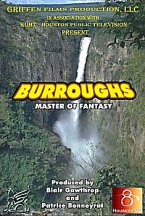 |
To date nothing significant has ever been produced about Edgar Rice
Burroughs and no documentary focusing on his life and career has ever been
made. We feel it is time to put him on the level of H.G. Wells and Jules
Verne. The purpose of Burroughs: Master of Fantasy is to tell the life
story of the father of adventure and fantasy, ERB. This piece will inspire
a sense of pride in the legacy that Burroughs brought to the art of adventure
writing as a genre and a deeper appreciation for the importance of preserving
its history for future generations.
Griffen Films Productions, LLC and KUHT-Houston PBS are proud to present Burroughs: Master of Fantasy, the true story of the man. This documentary will follow the life of the Burroughs family after the Civil War. An introduction on the kind of society in which ERB grew up is going to be essential to understand his state of mind. The industrial revolution brought incertitude to the population regarding the new technologies and their use. A free mind like that of ERB was shut down and his professional misfortune ended when he could finally express himself through writing. At last, his mind could go where it wanted to: inside the imaginary world. |
Griffen Films Productions, LLC and KUHT-Houston PBS are proud to present Burroughs: Master of Fantasy, the true story of the man. This documentary will follow the life of the Burroughs family after the Civil War. An introduction on the kind of society in which ERB grew up is going to be essential to understand his state of mind. The industrial revolution brought incertitude to the population regarding the new technologies and their use. A free mind like that of ERB was shut down and his professional misfortune ended when he could finally express himself through writing. At last, his mind could go where it wanted to: inside the imaginary world.We will also follow ERB's personal life and career through his books and the different characters that he created.
Following in parallel will be a description of the society in which Burroughs' writing evolved: the motion picture as a new art form, WWI, the pulp fiction magazines, the 1929 Wall Street crash, the first comic books etc.We hope you will come and join us as we explore the life and times of Edgar Rice Burroughs - the man and the writer. You can check out the promotional trailer for this Edgar Rice Burroughs documentary in Windows Media Format at:
www.griffenfilms.com/burroughs.html
(no longer active)
